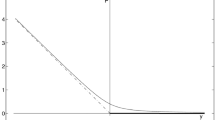Abstract
Since Dantzig—Wolfe's pioneering contribution, the decomposition approach using a pricing mechanism has been developed for a wide class of mathematical programs. For convex programs a linear space of Lagrangean multipliers is enough to define price functions. For general mathematical programs the price functions could be defined by using a subclass of nondecreasing functions. However the space of nondecreasing functions is no longer finite dimensional. In this paper we consider a specific nonconvex optimization problem min {f(x):h j (x)⩽g(x),j=1, ⋯,m, x∈X}, wheref(·),h j (·) andg(·) are finite convex functions andX is a closed convex set. We generalize optimal price functions for this problem in such a way that the parameters of generalized price functions are defined in a finite dimensional space. Combining convex duality and a nonconvex duality we can develop a decomposition method to find a globally optimal solution.
Similar content being viewed by others
References
E. Asplund, “Differentiability of the metric projection in finite dimensional Euclidean space,”Proceedings of the American Mathematical Society 38 (1973) 218–219.
R.E. Burkard, H.W. Hamacher and J. Tind, “On general decomposition schemes in mathematical programming,”Mathematical Programming Study 24 (1985) 238–252.
R.E. Burkard, H.W. Hamacher and J. Tind, “On abstract duality in mathematical programming,”Zeitschrift für Operations Research 26 (1982) 197–209.
F.H. Clarke,Optimization and Nonsmooth Analysis (Wiley, New York, 1983).
G.B. Dantzig and P. Wolfe, “The decomposition algorithm for linear programs,”Econometrica 29 (1961) 767–778.
A.M. Geoffrion, “Primal resource-directive approaches for optimizing nonlinear decomposable systems,” Working paper 141, the RANK Corporation (Santa Monica, CA, 1968).
R.J. Hillestad and S.E. Jacobsen, “Reverse convex programming,”Applied Mathematics and Optimization 6 (1980) 63–78.
J.B. Hiriart-Urruty, “Generalized differentiability, duality and optimization for problems dealing with differences of convex functions,”Lecture Notes in Economics and Mathematical Systems No. 256 (Springer, Berlin, 1985) pp. 37–69.
R. Horst and H. Tuy,Global Optimization: Deterministic Approaches (Springer, Berlin, 1990).
T. Kuno, Y. Yajima and H. Konno, “An outer approximation method for minimizing the product of several convex functions on a convex set,” IHSS Report N. 91-33, Institute of Human and Social Sciences, Tokyo Institute of Technology (Tokyo, 1991).
L.S. Lasdon,Optimization Theory for Large Systems (Macmillan, New York, 1970).
G.L. Nemhauser and Z. Ullmann, “A note on the generalized Lagrange multiplier solution to an integer programming problem,”Operations Research 16 (1968) 450–453.
G.L. Nemhauser and L.A. Wolsey,Integer and Combinatorial Optimization (Wiley, New York, 1988).
R.T. Rockafellar,Convex Analysis (Princeton University Press, Princeton, NY, 1970).
P.T. Thach, “Quasiconjugates of functions, duality relationship between quasiconvex minimization under a reverse convex constraint and quasiconvex maximization under a convex constraint and its applications,”Journal of Mathematical Analysis and Applications 159 (1991) 299–322.
P.T. Thach, R.E. Burkard and W. Oettli, “Mathematical programs with a two-dimensional reverse convex constraint,”Journal of Global Optimization 1 (1991) 145–154.
P.T. Thach, “A decomposition method using a pricing mechanism for min concave cost flow problems with a hierarchical structure,”Mathematical Programming 53 (1992) 339–359.
J. Tind and L.A. Wolsey, “An elementary survey of general duality theory in mathematical programming,”Mathematical Programming 21 (1981) 241–281.
J. Tind, “Decomposition in global optimization,”Journal of Global Optimization 1 (1991) 131–144.
H. Tuy, “A general deterministic approach to global optimization via d.c. programming,” in: J.-B. Hiriart-Urruty, ed.,Mathematics for Optimization (Elsevier, Amsterdam, 1986) pp. 137–162.
H. Tuy and N.V. Thuong, “Minimizing a convex function over the complement of a convex set,”Methods of Operations Research 49 (1985) 85–89.
L.A. Wolsey, “Integer programming duality: price functions and sensitivity analysis,”Mathematical Programming 21 (1981) 241–281.
Author information
Authors and Affiliations
Additional information
This paper is dedicated to Phil Wolfe on the occasion of his 65th birthday.
Rights and permissions
About this article
Cite this article
Thach, P.T., Konno, H. A generalized Dantzig—Wolfe decomposition principle for a class of nonconvex programming problems. Mathematical Programming 62, 239–260 (1993). https://doi.org/10.1007/BF01585169
Received:
Revised:
Issue Date:
DOI: https://doi.org/10.1007/BF01585169




